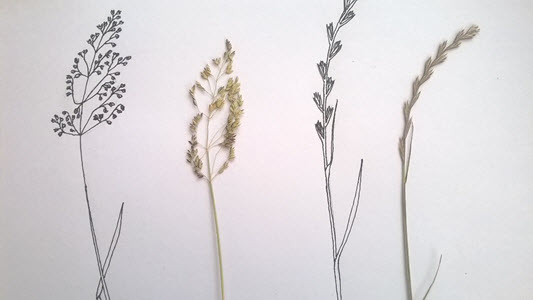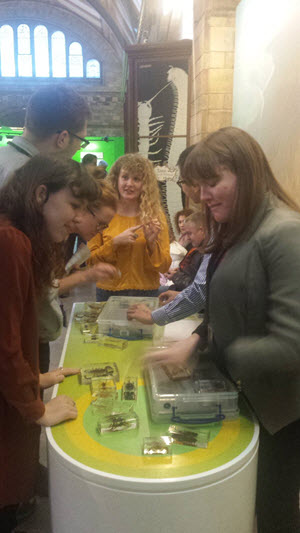Written by Mike Waller
I refuse to draw attention to how little time we have left – it simply makes me sad. But unfortunately it’s true. That said, the work flow and general business amongst us trainees hasn’t slowed, not even a little bit!
Of course, our final projects are now in full flow with a wild assemblage of books, papers and stationery sprawled across our desk space. Sally has now come through her tumultuous indecision (project ideas swung between Waxcaps and Agaric fungi before finally settling) and is now blazing ahead with her multi-access grass key. Like myself, she’s now taken to illustrating her project with an exquisite selection of grass anatomy drawings which she is in the process of scanning in the digitisation department. One thing we’ve learnt over the course of the traineeship is that keys are much more effective when they include images to define a description.

Chloe has been working extremely hard to develop her Shrill Carder Bumblebee and Great Yellow Bumblebee ID cards for beta testing with the wider public and naturalist community. If all goes to plan, these will be rolled out to areas where these declining species still persist with the hope of generating more records by raising awareness. Her project will, uniquely, feed directly into the wider work of the Bumblebee Conservation Trust and their conservation schemes. Luckily she’s already had the chance to deploy her cards for testing amongst us as part of our recently completed ‘Train the Trainer’ course.
Between outbursts of beetle-based statements like ‘Oh I love them!’ and ‘Look at his fuzzy nose!’, Katy has been working equally hard on her beetle workshop plans. She’s been able to include her superb photo-stacked images of her specimens as debuted in the last update whilst developing her introductory talk. Ideally her workshop will be carried out here at the Natural History Museum before we leave.
Anthony’s project has been, in truth, rather mysterious! He’s a private worker who frequently whisks himself away to the outer reaches of the Angela Marmont Centre offices but I’ve just this second been given a comprehensive update. His main focus has been deciding on which species and groups to include in his guide to the upper strand line of beaches. In order to achieve this, he’s been liaising with various museum experts and has recently had a meeting with the Marine Biological Association to develop his ideas. So far so good!
Finally is my project – a vegetative guide to British orchids. Again, so far so good. Most difficult has been sourcing good quality photos of the leaves or ‘rosettes’ (circular formation of leaves on flat to the ground that many species form) of the slightly rarer species. To address this issue I’ve been developing a selection of drawings to help illustrate each genus. The overall plan is to integrate my identification pages for each species and genus into PDF documents which will then be linked together to create a PDF network. This will avoid the potentially expensive and time-consuming process of developing a website.
But that’s just the projects! We’re now waist-deep in our learning and people engagement sessions, having just today finished our week learning to manage volunteers with the volunteer management team. A genuinely fantastic experience and one we were able to repay with a selection of specimen-rich engagement activities designed for families to present to members of the public. The theme was ‘spot the difference’, focussing on camouflage, mimicry, eye-spot deterrents and recurring forms and shapes in nature.
The week previous to that was a crash course in object handling and learning techniques with the learning engagement team. We were thrown in at the deep end exploring specimens with school groups in the Investigate teaching and learning room and taking specimens out into the galleries, asking the unsuspecting to make their own inquiries to learn about the specimens – a totally unique and fascinating technique that is learner-led. Hopefully this will put us all in good stead for February when we spend two whole weeks engaging school and family groups over the manic half term period!

